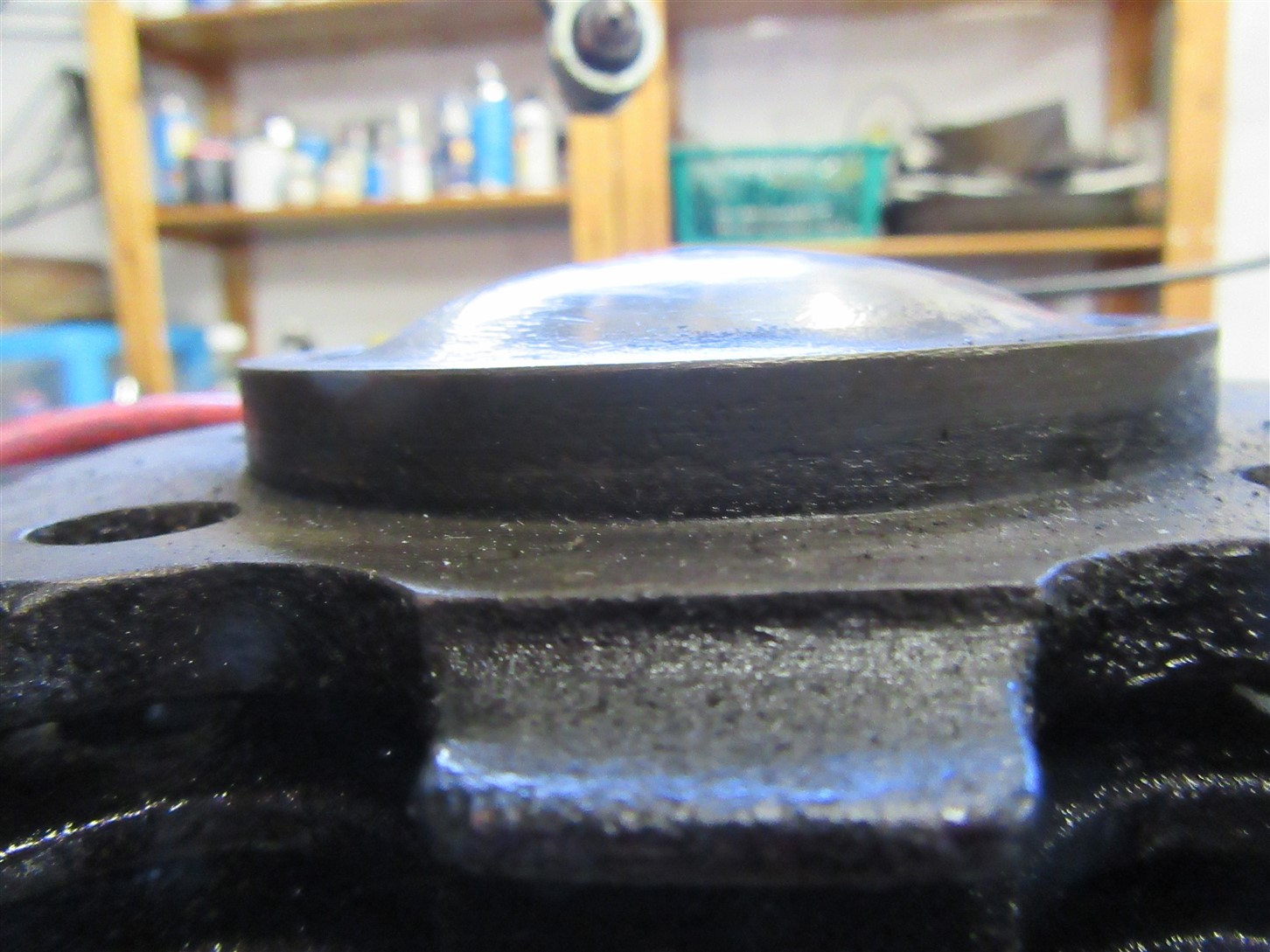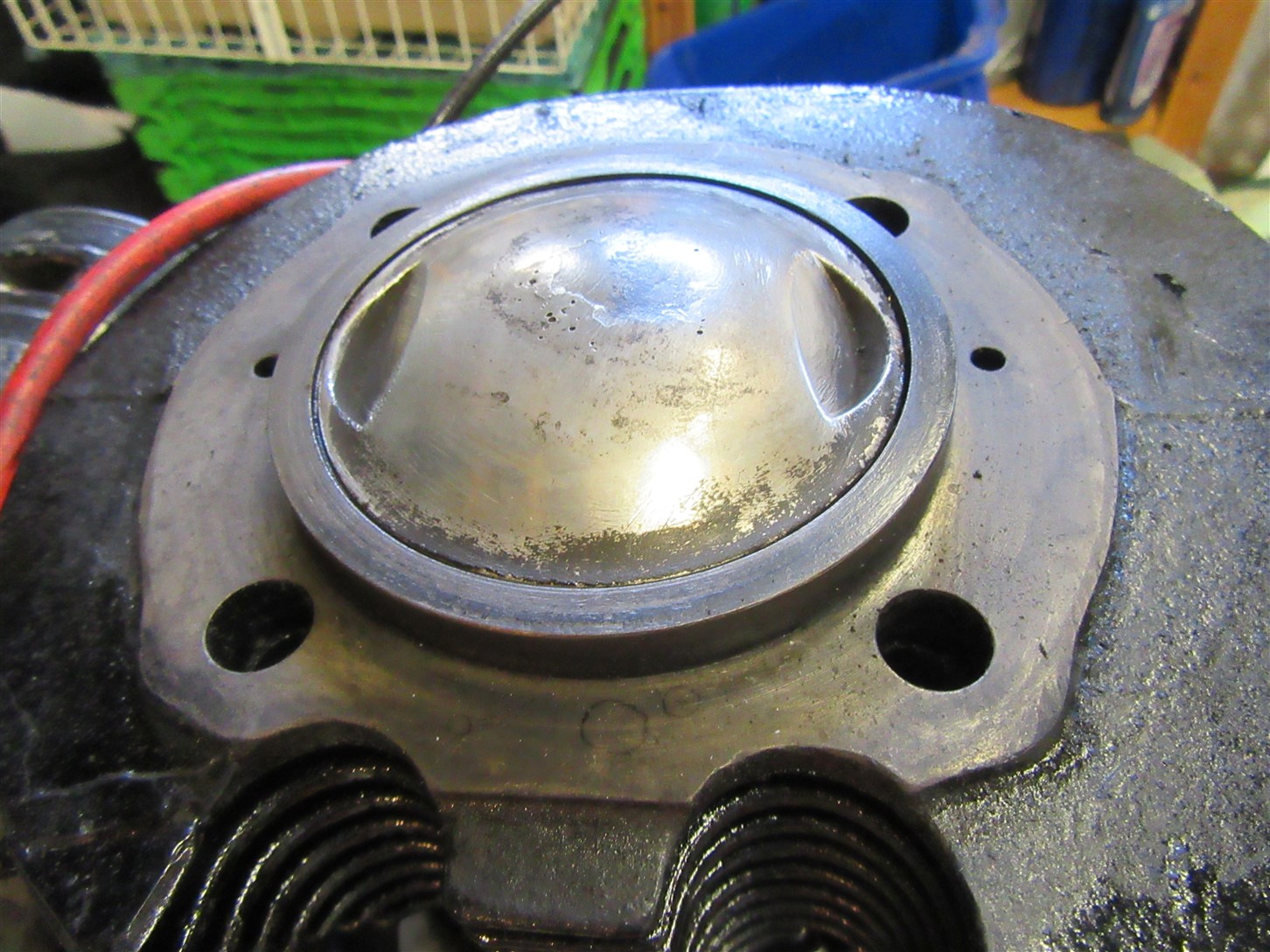I currently have the cylinder head (cast iron) off my 1952 ES2 to repair a couple of broken fins. I was quite surprised to see a domed piston with the dome height above the joint face of about 1 cm. I thought the pistons on these were flat topped.
Anyway, I thought I'd calculate what the volume of the dome was using a formula from Wikipedia - https://en.wikipedia.org/wiki/Spherical_cap#Volume_and_surface_area (my A level maths being rather rusty) and it came out at around 25cc.
I also used the same formula to calculate the combustion chamber volume assuming a flat top piston level with the joint face and it came out at 88.7cc which gives a compression ratio of 6.6:1 (my bike has a +.040" rebore giving a bore of 80mm). In other words, a flat top piston would give the CR as in the specification.
If I subtract the value of the dome from the combustion chamber volume I get just over 66cc for the actual combustion chamber which results in a compression ratio of 8.8:1. Allowing for valve pockets, inaccuracies in my measurement etc it's still going to be north of 8:1.
The bike runs perfectly, doesn't pink or detonate even on full advance of 5/8" and has a very lively performance so I plan to leave well alone. I suspect that modern petrol, although reviled by some, is that much better than the stuff available just post-war.
Any comments?
ES2 compression ratio.
- Log in to post comments
Could be...
.. Richard although the valve pockets in the dome look very original (I haven't bothered cleaning the carbon off as it's all quite clean but may do so later). I assume that a 16H piston wouldn't have any valve pockets.... I'll also take a pic to upload.
There is no gasket fitted; it's obviously been ground in as there was no leakage from the head joint. When I refit it I'll use a very thin smear of Wellseal on the small spigot and round the oil drain holes.
It's many years since my last Norton single but vibration isn't an issue and I would say on a par with the Velo Venom and Matchless G80 I've owned in te more recent past.
- Log in to post comments
Stage 1 tuning
Ian,
As Richard says, this is the first stage for tuning the ES2 engine and is similar to what Mike Pemberton does. The valve pockets have been machined out nicely. Do you have an enlarged inlet tract (sounds rather personal!) to improve the carburation?
When Mike modified my engine, with an alloy head, he modified the inlet tract so that it is down draught and enlarged to 34mm. So I have fitted the largest Monoblock that I could find, I think 1 7/32", or alternatively a Mk2 concentric was recommended by Mike.
If it's working well I'd leave it alone and enjoy it as it is.
Philip
- Log in to post comments
Inlet tract
It should have a clip fitting pre-monobloc carb but instead has a quite nicely made alloy inlet adaptor with a flange and is currently fitted with a 1.1/16" Monobloc which has been working very well.
I've ordered a quicker action twistgrip from RGM as the existing one needs 2 handfuls for full throttle!
I don't really want to increase the carb size as I'm rarely on full chat anyway......
- Log in to post comments
ES2 Inlet tract
Ian,
Sounds like you have an inlet tract from the alloy head ES2, which as you say is made of aluminium and screws into the head, with a locknut to hold it firmly in place. This then has a flange for a Monoblock carburetor to fit onto. If you zoom into the attached photo you should be able to see the carburetor fitting. Your 1.1/16" Monoblock should be fine.
I find that brakes dictate the speed that I ride at, even though I've got the 8" front brake! When I tour two up, with panniers, I swap the front wheel for one with a twin leading shoe brake. This certainly helps when riding the by-roads in Wales.
- Log in to post comments






Hi Ian,
It sounds like you have a pre 1948 16H piston fitted, I think the Hepolite number is 8617. This was one of my early attempts at tuning as an 18 year old back in the early 1970s and it really made a difference showing 90mph on the clock with the wind behind me!
Your calculations look pretty accurate as I came up with similar figures and this is about the maximum ratio when using a cast-iron head. I would personally use premium grade 97 RON octane which is close to the old leaded 4 star.
To fit one of these pistons you need to shorten the skirt and cut some valve recesses but you need to be very careful you don't go too deep into the crown or this could burn through. The skirt on these pistons usually has oil grooves machined in and you need to cut it off at least the bottom groove to miss the flywheels. Every thing else should be the same, although the 16H piston will be heavier.
So Ian, are you using a head gasket and do you find the bike vibrates more than you would expect ?